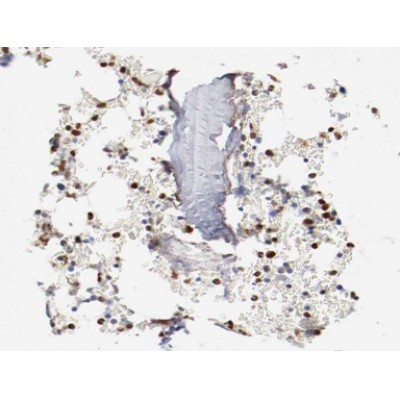C/EBP epsilon Antibody - #AF0085
| Product: | C/EBP epsilon Antibody |
| Catalog: | AF0085 |
| Description: | Rabbit polyclonal antibody to C/EBP epsilon |
| Application: | WB IHC IF/ICC |
| Reactivity: | Human |
| Prediction: | Pig, Bovine, Horse, Sheep, Rabbit, Dog |
| Mol.Wt.: | 34kDa; 31kD(Calculated). |
| Uniprot: | Q15744 |
| RRID: | AB_2833271 |
Product Info
*The optimal dilutions should be determined by the end user.
*Tips:
WB: For western blot detection of denatured protein samples. IHC: For immunohistochemical detection of paraffin sections (IHC-p) or frozen sections (IHC-f) of tissue samples. IF/ICC: For immunofluorescence detection of cell samples. ELISA(peptide): For ELISA detection of antigenic peptide.
Cite Format: Affinity Biosciences Cat# AF0085, RRID:AB_2833271.
Fold/Unfold
C/EBP epsilon; CCAAT/enhancer binding protein (C/EBP) epsilon; CCAAT/enhancer binding protein epsilon; CCAAT/enhancer-binding protein epsilon; CEBPE; CEBPE_HUMAN; CRP 1; CRP1;
Immunogens
A synthesized peptide derived from human C/EBP epsilon, corresponding to a region within the internal amino acids.
- Q15744 CEBPE_HUMAN:
- Protein BLAST With
- NCBI/
- ExPASy/
- Uniprot
MSHGTYYECEPRGGQQPLEFSGGRAGPGELGDMCEHEASIDLSAYIESGEEQLLSDLFAVKPAPEARGLKGPGTPAFPHYLPPDPRPFAYPPHTFGPDRKALGPGIYSSPGSYDPRAVAVKEEPRGPEGSRAASRGSYNPLQYQVAHCGQTAMHLPPTLAAPGQPLRVLKAPLATAAPPCSPLLKAPSPAGPLHKGKKAVNKDSLEYRLRRERNNIAVRKSRDKAKRRILETQQKVLEYMAENERLRSRVEQLTQELDTLRNLFRQIPEAANLIKGVGGCS
Predictions
Score>80(red) has high confidence and is suggested to be used for WB detection. *The prediction model is mainly based on the alignment of immunogen sequences, the results are for reference only, not as the basis of quality assurance.
High(score>80) Medium(80>score>50) Low(score<50) No confidence
Research Backgrounds
Transcriptional activator. C/EBP are DNA-binding proteins that recognize two different motifs: the CCAAT homology common to many promoters and the enhanced core homology common to many enhancers. Required for the promyelocyte-myelocyte transition in myeloid differentiation.
Phosphorylated.
Nucleus.
Strongest expression occurs in promyelocyte and late-myeloblast-like cell lines.
Belongs to the bZIP family. C/EBP subfamily.
Research Fields
· Human Diseases > Cancers: Overview > Transcriptional misregulation in cancer.
· Human Diseases > Cancers: Specific types > Acute myeloid leukemia. (View pathway)
Restrictive clause
Affinity Biosciences tests all products strictly. Citations are provided as a resource for additional applications that have not been validated by Affinity Biosciences. Please choose the appropriate format for each application and consult Materials and Methods sections for additional details about the use of any product in these publications.
For Research Use Only.
Not for use in diagnostic or therapeutic procedures. Not for resale. Not for distribution without written consent. Affinity Biosciences will not be held responsible for patent infringement or other violations that may occur with the use of our products. Affinity Biosciences, Affinity Biosciences Logo and all other trademarks are the property of Affinity Biosciences LTD.
